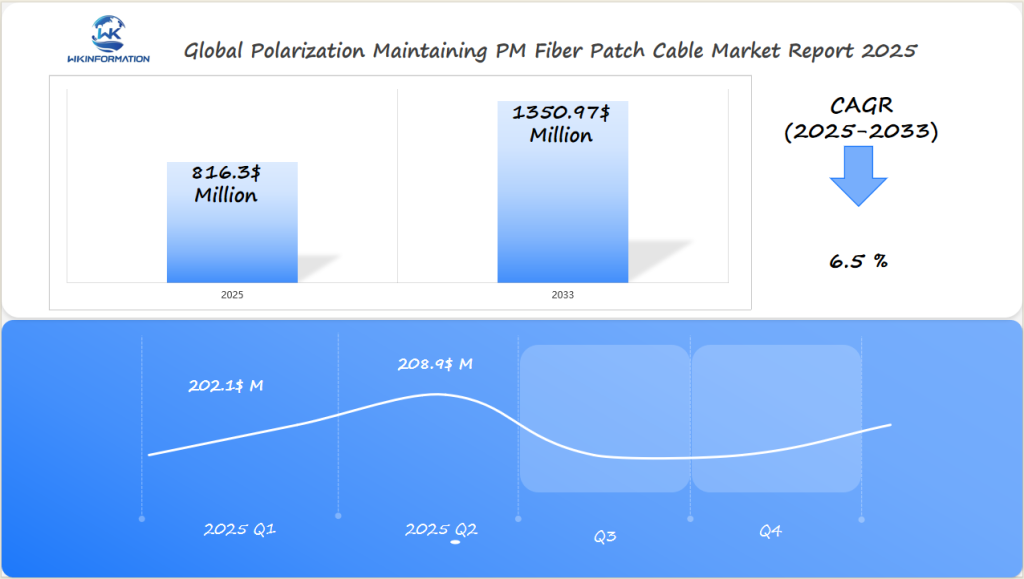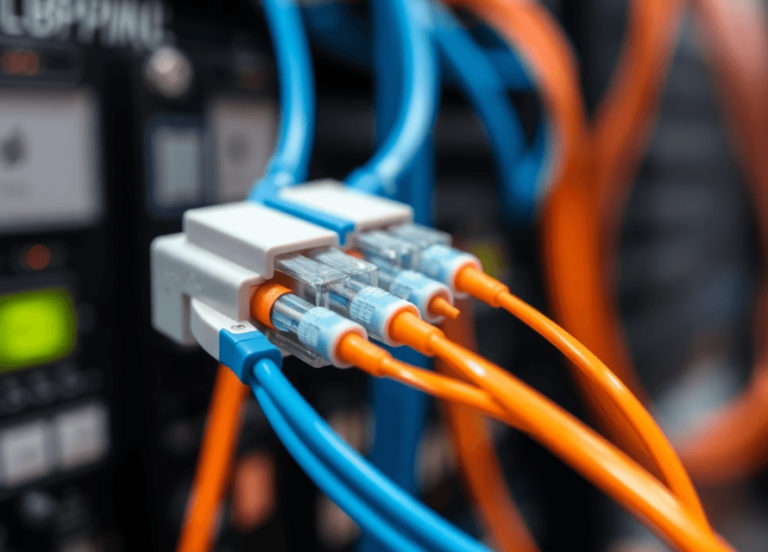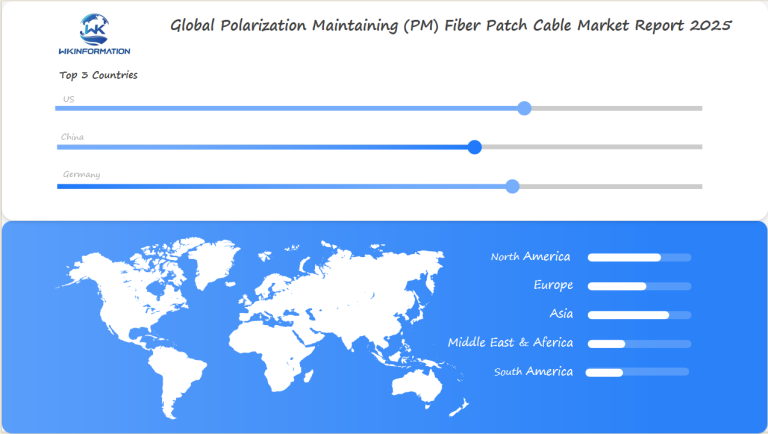Polarization Maintaining (PM) Fiber Patch Cable Market to Surpass $816.3 Million by 2025 with US, China, and Germany Leading the Charge
Discover insights into the 2025 Polarization Maintaining PM Fiber Patch Cable Market, analyzing growth trends across US, China, and Germany. This report explores technological innovations, market dynamics, and geopolitical impacts, including Trump’s tech policies. Learn about regional strategies, investment opportunities, and future market projections in fiber optic technology.
- Last Updated:
Polarization Maintaining PM Fiber Patch Cable Market Forecast for Q1 and Q2 of 2025
The PM Fiber Patch Cable market was valued at USD 816.3 million in 2025, growing at a CAGR of 6.5% from 2025 to 2033. The first half of 2025 will experience steady growth, particularly in key markets like the US, China, and Germany, which are at the forefront of advancements in telecommunications and optical networks.
In Q1, the market is expected to reach approximately USD 202.1 million, with the US leading in demand due to increasing investments in optical networks and communication infrastructure. China’s rapid expansion in its telecommunications sector, coupled with the rise of 5G technology, will also drive the market. Germany’s strong industrial and technological infrastructure will contribute to the growth of the PM fiber patch cable market as it continues to adopt advanced fiber-optic solutions. By Q2, the market is projected to grow to around USD 208.9 million, with ongoing investments in communication technologies across these regions fueling growth.

Polarization Maintaining (PM) Fiber Patch Cable Market Upstream and Downstream Industry Chain Analysis
Understanding the supply chain of PM fiber patch cables involves examining both upstream and downstream components.
Upstream Components
At the core of the upstream processes are the raw materials essential for manufacturing PM fibers, such as high-purity silica and specialized dopants. The manufacturing process is intricate, involving precise control of stress-induced birefringence to maintain polarization, crucial for applications demanding high stability.
Downstream Components
On the downstream side, PM fiber patch cables find applications in various sectors:
- The telecommunications industry relies heavily on these fibers for maintaining signal integrity over long distances.
- In the aerospace sector, they are pivotal in systems requiring precise optical performance under variable conditions.
Role of Distribution Channels
Distribution channels play a critical role in market dynamics. Distributors ensure that these high-tech products reach end-users efficiently, bridging the gap between manufacturers and consumers. They facilitate market growth by making PM fiber products readily available across different regions, thus supporting widespread adoption.
The interconnectedness of these elements underscores the complexity and importance of each stage in delivering high-quality PM fiber patch cables to diverse global markets.
Emerging Trends in the Polarization Maintaining (PM) Fiber Patch Cable Market
The adoption of PM fiber patch cords is accelerating across various sectors. Key drivers include the demand for precision and stability in applications such as telecommunications, aerospace, and defense. These sectors benefit from PM fibers’ ability to maintain polarization, crucial for signal integrity.
Innovations in fiber technology are shaping the future of PM fibers. Advancements in manufacturing techniques have led to enhanced performance specifications, making these fibers more reliable and efficient. Improved stress-induced birefringence allows for better preservation of polarization states, meeting the stringent requirements of high-performance systems.
The increasing demand for high-performance communication systems is significantly impacting the market for PM fiber patch cables. As industries push for faster and more reliable data transmission, the need for cables that offer low insertion loss and high extinction ratios grows. This trend underscores the importance of continuous innovation and adaptation within the industry to meet evolving customer demands.
Industry trends indicate a strong trajectory towards broader market adoption, driven by technological advancements and the growing emphasis on system performance and reliability. The landscape is set for further developments as sectors continue to integrate these advanced optical solutions into their operations.
Challenges and Restrictions in the Polarization Maintaining Fiber Patch Cable Market
Manufacturers in the Polarization Maintaining (PM) Fiber Patch Cable Market face significant challenges. A primary concern is achieving production scalability while keeping costs down. Scaling up production often leads to higher expenses, requiring innovative approaches to streamline processes without compromising quality.
Regulatory restrictions are another obstacle, especially for new market entrants. Following strict industry standards and obtaining necessary certifications can be both time-consuming and expensive. These challenges often discourage smaller companies from entering the market, limiting competition and innovation.
The competition in the PM fiber patch cable sector is fierce, with established players holding a large share of the market. Companies must strategically navigate this environment to grow. This includes investing in research and development to improve product offerings and stand out from competitors. Understanding these factors is crucial for companies looking to succeed in this rapidly changing market.

Geopolitical Factors Affecting the PM Fiber Patch Cable Market
Geopolitical factors play a significant role in shaping the supply chains for Polarization Maintaining (PM) fiber patch cables. This is especially true in regions such as Asia-Pacific and North America.
Impact of Tensions Between Major Economies
Tensions between major economies can disrupt the manufacturing and distribution processes of PM fiber patch cables. For example, if diplomatic relations between two countries fluctuate, it may result in delays or increased costs due to sanctions or trade barriers.
Influence of Trade Policies
Trade policies are another critical aspect that impacts the dynamics of the PM fiber patch cable market. Import/export tariffs can change competitive pricing structures, which in turn affects both regional markets and global trade. Countries often enter into trade agreements that can either facilitate or hinder the movement of PM fiber products across borders.
For instance, favorable trade deals between the US and Europe might make it easier for PM fiber products to be accessed in those markets. On the other hand, restrictive policies could impede growth in other areas by making it more difficult for PM fiber products to enter those markets.
Importance of Understanding Geopolitical Elements
For companies looking to navigate the complexities of the global PM fiber patch cable market effectively, understanding these geopolitical factors is crucial. By being aware of how tensions between major economies and trade policies can impact their supply chains, companies can better prepare themselves to adapt to any challenges that may arise.
Segmentation by Type: Panda Fibers vs Bow-Tie Fibers in the PM Fiber Patch Cable Market
Understanding the distinct characteristics of Polarization Maintaining (PM) fibers is crucial for selecting the right product for specific applications. Two prominent types—Panda fibers and Bow-Tie fibers—dominate the market, each offering unique features tailored to various industry needs.
Panda Fibers
- Structure: Named for their resemblance to a panda’s face, these fibers feature two stress rods positioned symmetrically around the core.
- Applications: Widely used in telecommunications and high-stability laser systems where maintaining polarization over long distances is vital.
- Advantages: Offer high extinction ratios and superior thermal stability, making them ideal for environments requiring precise polarization control.
Bow-Tie Fibers
- Structure: Characterized by their bow-tie shape created through elliptical stress regions around the core.
- Applications: Commonly found in aerospace and defense sectors due to their robustness against environmental changes.
- Advantages: Deliver excellent performance under mechanical stress and are less sensitive to external perturbations, which is beneficial for dynamic applications.
Both fiber types play crucial roles within the PM Fiber Patch Cable Market. While Panda fibers excel in telecommunications for stable signal transmission, Bow-Tie fibers provide resilience under challenging conditions. Selecting between them depends on specific requirements such as environmental conditions and required signal integrity.
Analyzing Applications Beyond Telecommunications: Exploring Diverse Use Cases for Polarization Maintaining Fiber Patch Cables
Polarization Maintaining (PM) fiber patch cables are finding applications beyond traditional telecommunications, expanding their utility across various advanced sectors. Key areas include:
- Medical Imaging Systems: PM fibers enhance the precision and reliability of imaging technologies, crucial for diagnostics and research.
- Quantum Computing Research Facilities: As quantum computing evolves, the demand for high-performance optical components like PM fibers grows, supporting complex computations that rely on maintaining polarization states.
- Aerospace and Defense: These sectors leverage PM fibers for their ability to maintain signal integrity under extreme conditions, essential for secure communications and advanced sensor technologies.
Other emergent use cases include fiber optic sensing systems in industrial automation and environmental monitoring. The adaptability of PM fiber patch cables to meet stringent performance standards makes them indispensable in these diverse applications, driving growth in the market well beyond its telecommunication roots.
Global Growth Projections: Regional Insights on Revenue Drivers Behind The Surge In Demand For Polarization Maintaining Fiber Patch Cables By 2025 ($816.3 Million)
The anticipated global growth projections for the Polarization Maintaining Fiber Patch Cable Market highlight significant revenue drivers contributing to its expansion. Several factors are fueling this growth across various regions:
- Increasing Internet Penetration: As internet connectivity becomes more widespread, the demand for high-performance communication systems using PM fiber patch cables is accelerating. This trend is especially evident in emerging economies, where studies have shown a direct impact of internet on economic growth. For instance, initiatives aimed at expanding broadband access in countries like Azerbaijan are set to further boost demand for such high-performance fiber cables.
- Country-Specific Growth Leaders:
- India: With a rapidly growing telecommunications sector and government initiatives aimed at expanding digital infrastructure, India is poised to be a major player in this market.
- Brazil: The country’s emphasis on modernizing its telecommunications networks presents a lucrative opportunity for PM fiber patch cable manufacturers.
These regional dynamics underscore the importance of understanding localized market drivers as companies strategize to capitalize on the projected $816.3 million market value by 2025.

US Polarization Maintaining (PM) Fiber Patch Cable Market Analysis
The United States dominates the PM fiber patch cable market, driven by advanced telecommunications infrastructure, a high concentration of tech companies and research institutions, and substantial investments in quantum computing and aerospace sectors. Additionally, growing demand from medical device manufacturers and a strong presence of leading PM fiber manufacturers further contribute to its market leadership.
The market growth is further accelerated by factors such as the expansion of 5G networks, increasing fiber-to-the-home (FTTH) deployments, rising demand for high-speed internet connectivity, and government initiatives supporting digital infrastructure development.
China PM Fiber Patch Cable Market Analysis and Demand
China’s PM fiber patch cable market exhibits strong growth potential, fueled by massive investments in digital infrastructure, rapid industrialization, and technological advancements. The growing telecommunications sector, increasing domestic manufacturing capabilities, and rising demand from emerging tech industries further enhance its growth prospects.
Key demand drivers include the “Made in China 2025” initiative, the expansion of 5G networks, growing applications in fiber optic sensing, and increasing adoption in industrial automation. Additionally, rising demand from research institutions plays a significant role in driving the market forward.
Germany PM Fiber Patch Cable Market and Future Growth Potential
Germany’s PM fiber patch cable market shows promising growth prospects, driven by a strong industrial base and manufacturing sector, high investment in Industry 4.0 initiatives, and advanced research and development facilities. The growing adoption of PM fiber in the automotive and aerospace industries, along with a strong focus on technological innovation, further supports its market growth.
Growth potential is enhanced by digital transformation initiatives, increasing demand for high-speed connectivity, and rising adoption in medical devices. Additionally, growing quantum computing research and the expansion of fiber optic networks contribute to the market’s upward trajectory.
Future Development Trajectories & Competitive Strategies Shaping The Landscape Of The Polarization Maintaining Fiber Patch Cable Industry
The future development trajectories of the Polarization Maintaining (PM) Fiber Patch Cable industry promise significant advancements. Anticipated technological innovations aim to push the boundaries of performance specifications and industry standards. Increased bandwidth capacity is a primary focus, driven by the growing demand for high-speed communication systems.
Key players are investing in research and development to enhance fiber quality and reliability. This includes improvements in stress-induced birefringence techniques, which are crucial for maintaining polarization over longer distances and in varying environmental conditions.
Strategic collaborations and partnerships are emerging as competitive strategies. These alliances enable the sharing of technological expertise and resources, facilitating quicker advancements. Distributors play a vital role in expanding market reach, ensuring that new technologies meet global demand efficiently.
The exploration of new applications beyond traditional markets is also on the rise, offering fresh opportunities for growth and innovation within the industry.
Competitive Landscape in the Polarization Maintaining Fiber Patch Cable Market
The competitive landscape in the Polarization Maintaining (PM) Fiber Patch Cable Market is characterized by several key players vying for market share through technological innovation and strategic partnerships. Leading manufacturers focus on product differentiation, quality control, and expanding their global presence to maintain competitive advantages.
Key Players:
- Fibercore – UK
- Thorlabs – USA
- Newport – USA
- RP Photonics – Austria
- Fibertronics, Inc. – USA
- CRXCONEC – China
- Corning – USA
- OFS – USA
- Fujikura – Japan
- Sumitomo Electric – Japan
Overall
| Report Metric | Details |
|---|---|
| Report Name | Global Polarization Maintaining PM Fiber Patch Cable Market Report |
| Base Year | 2024 |
| Segment by Type |
· Panda PM Fiber · Bow-Tie PM Fiber |
| Segment by Application |
· Long-Distance Signal Transmission · High-Speed Data Networks · Environmental Resilience · Others |
| Geographies Covered |
· North America (United States, Canada) · Europe (Germany, France, UK, Italy, Russia) · Asia-Pacific (China, Japan, South Korea, Taiwan) · Southeast Asia (India) · Latin America (Mexico, Brazil) |
| Forecast units | USD million in value |
| Report coverage | Revenue and volume forecast, company share, competitive landscape, growth factors and trends |
Understanding the Polarization Maintaining (PM) Fiber Patch Cable Market is crucial for staying competitive. Engaging with current trends and recognizing challenges allows stakeholders to adapt strategies effectively. As customer demands evolve, investing in knowledge and innovation provides a pathway to success.
The growth trajectory of this market offers numerous opportunities, making it essential for industry players to remain vigilant and proactive in their approach. This understanding not only aids in navigating fierce competition but also ensures alignment with dynamic market needs, ultimately driving sustainable growth and profitability.
Global Polarization Maintaining PM Fiber Patch Cable Market Report (Can Read by Free sample) – Table of Contents
Chapter 1: Polarization Maintaining PM Fiber Patch Cable Market Analysis Overview
- Competitive Forces Analysis (Porter’s Five Forces)
- Strategic Growth Assessment (Ansoff Matrix)
- Industry Value Chain Insights
- Regional Trends and Key Market Drivers
- Polarization Maintaining PM Fiber Patch Cable Market Segmentation Overview
Chapter 2: Competitive Landscape
- Global Polarization Maintaining PM Fiber Patch Cableplayers and Regional Insights
- Key Players and Market Share Analysis
- Sales Trends of Leading Companies
- Year-on-Year Performance Insights
- Competitive Strategies and Market Positioning
- Key Differentiators and Strategic Moves
Chapter 3: Polarization Maintaining PM Fiber Patch Cable Market Segmentation Analysis
- Key Data and Visual Insights
- Trends, Growth Rates, and Drivers
- Segment Dynamics and Insights
- Detailed Market Analysis by Segment
Chapter 4: Regional Market Performance
- Consumer Trends by Region
- Historical Data and Growth Forecasts
- Regional Growth Factors
- Economic, Demographic, and Technological Impacts
- Challenges and Opportunities in Key Regions
- Regional Trends and Market Shifts
- Key Cities and High-Demand Areas
Chapter 5: Polarization Maintaining PM Fiber Patch Cable Emerging and Untapped Markets
- Growth Potential in Secondary Regions
- Trends, Challenges, and Opportunities
Chapter 6: Product and Application Segmentation
- Product Types and Innovation Trends
- Application-Based Market Insights
Chapter 7: Polarization Maintaining PM Fiber Patch Cable Consumer Insights
- Demographics and Buying Behaviors
- Target Audience Profiles
Chapter 8: Key Findings and Recommendations
- Summary of Polarization Maintaining PM Fiber Patch Cable Market Insights
- Actionable Recommendations for Stakeholders

Access the study in MULTIPLEFORMATS
Didn’t find what you’re looking for?
TALK TO OUR ANALYST TEAM
Need something within your budget?
NO WORRIES! WE GOT YOU COVERED!
Call us on: +1-866-739-3133
Email: infor@wkinformation.com
What is the significance of polarization maintaining (PM) fiber patch cables in modern technology?
Polarization maintaining (PM) fiber patch cables are crucial in telecommunications and various industries as they minimize signal degradation and enhance performance under varying conditions. They are essential for high-speed data transmission, especially in applications like fiber optic gyroscopes and sensors.
How do PANDA fibers differ from Bow-Tie fibers in terms of applications?
PANDA fibers and Bow-Tie fibers are two types of polarization maintaining fibers used in telecommunications. PANDA fibers are typically used for applications requiring high stability and low loss, while Bow-Tie fibers offer advantages in compact designs and can be more suitable for specific sensor applications.
What factors are driving the growth of the optical networking market?
Key drivers for growth in the optical networking market include the increasing adoption of cloud services, the rollout of 5G technology, and the rising demand for high-speed internet across various sectors, which are all contributing to a robust expansion in this industry.
How do geopolitical tensions affect the PM fiber patch cable market?
Geopolitical tensions can significantly impact trade policies affecting the PM fiber industry. These tensions may lead to increased competition among global manufacturers and influence market dynamics, potentially hindering innovation and collaboration within the sector.
What future trends can we expect in the PM fiber patch cable market beyond 2025?
Future trends in the PM fiber patch cable market beyond 2025 include continued technological advancements, increased investment opportunities driven by innovations, and a growing demand for high-performance communication solutions as industries adapt to emerging technologies.


